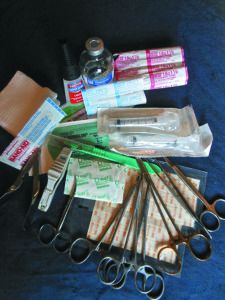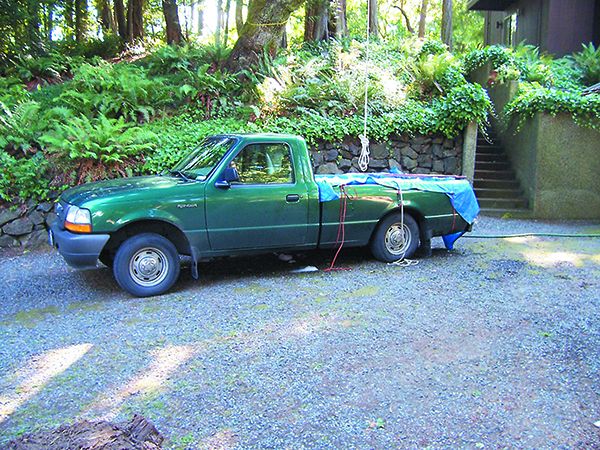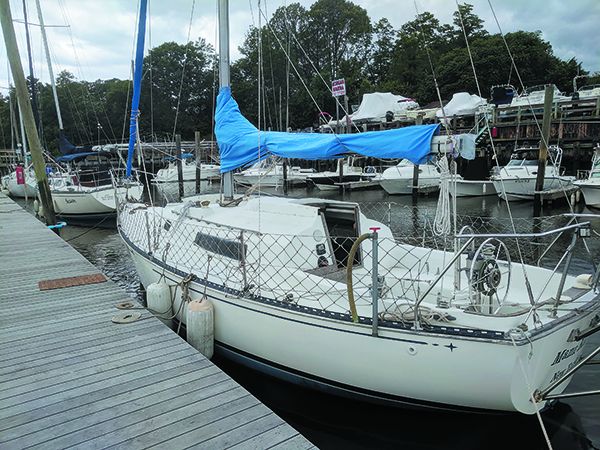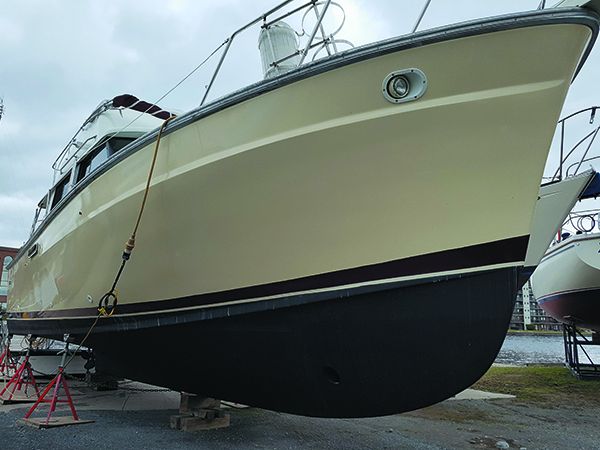Bottom Paint Removal Tips
I removed 40-plus years of bottom paint from half of my Catalina 27 hull over the weekend.
We laid down poly dropcloths, peeled off as much as possible with stiff narrow putty knives (sharpened with a file every few minutes) then sanded…and sanded. I may use a stripper for the trickiest spots, but one thing is for sure.
I would not sand an inch of it without a good quality sander/grinder with excellent dust pickup from a HEPA filter vac. I am a woodworker and use the Festool line of sanders and vacs, but there are others out there that do the job just as well.
I guess my point is, err on the side of guarding your health and local environment. We collected about 70 pounds of paint chips and more in the vac. The cleanup after would have been nearly impossible without those precautions. Inside our Tyvek suits, gloves, and respirators, we stayed clean. Outside we looked like blue Smurfs.
Hoping to have the same result on the starboard side.
Everett Andrews
Meerschaum,1976 Catalina 27
New Bedford, MA

An Epifanes Monourethane Fan
I have restored, modified, and repainted a few boats in my amateur days. Full disclosure, I am a former marine mechanic and have taught technologies for 20 years.
Brightsides has been an overall disappointment to me. In four attempts at repainting my Bluenose 24, (my brother-in-law is a rough-landing skipper), I only had the gloss come up once. The other three times the paint kicked too early or just cured dull.
In putting an epoxy bottom coat on my Shark 24, with Pettit epoxy, that claims to cure even down to 5 celsius, the paint started kicking on the roller leaving a bumpy mess like a teen’s complexion. Pettit replaced the product and after exhaustive grinding off the previous mess, it happened again. Pettit is off my list forever.
Epifanes has been my go-to choice for my trawler yacht, a Mainship Mk1. It has been the best experience of them all. Using a roll-and-tip method, the brush strokes did not level-out leaving noticeable lines up close. I contacted Epifanes Canada and they now recommend just rolling, and they are right. Just roll it on and it’s great. Yes the mono-urethanes are softer, but they are so much more user friendly when rolling on. A factor when some drydock locations would not allow spraying without building a full enclosure.
After my first season, a green dockhand caused a minor scratch with improper line handling. I called Epifanes and they advised just tape of a trapezoid shape around the scratch and repaint it. You will have to get real close to see the tape line. BAM! It worked just like they said. I now do not fear docking scratches as I know I can successfully with little fuss repair them during drydock times, or even afloat if need be.
I have no investment in any of these products. I am Epifanes sold. Awlgrip is too fussy for a DIY boatyard job. Unless you want to fork out big bucks, accept the four-foot test. If it looks great four feet away, be happy.
Rob Legate
Diamond Girl, 1978 Mainship 40
Bay of Quinte, Ontario, Canada
Epifanes mono-urethane scored well in both our most recent long-term tests of topside paints, rating as one of the harder one-part paints. We don’t expect the initial gloss of these one-part paints to last more than 3-4 years in year-round saltwater use. However, we were quite surprised in the last test, as tester Ralph Naranjo put it: “These paints have endured 3 years of sailing travails plus the onslaught of icy winters and boiling hot summers. The gloss has diminished some, but their adhesive quality as nonskid paints and waterway topcoats have been impressive.” See the editor’s blog post “Painting Your Boat Like a Pro,” at www.practical-sailor.com for links to past tests and helpful tips on painting. You can also search “Topside paint” for older archive articles, including a heroic effort by former PS editor Doug Logan, who painted a multi-hued “bracelet” around his Boston Whaler, which in the latter stages of the test, drew more than a few curioius stares.
With Covid-19 putting a damper on our usual routines, one spring ritual can be carried out safely in isolation—the spring cleaning/fitout. To keep busy, we have an endless supply of do-it-yourself projects, marine maintenance fun, and prep suggestions.
Health

Telemedicine is a hot topic these days and we took a deep dive into this technology in April 2014. In the June 2010 issue, we took a look at why hydrating is important and the best ways to stay hydrated at sea. Also at the top of the safety gear list is an onboard medical kit; our July 2014 article shows sailors how to cut expenses by building their own ship’s first-aid kit.
Maintenance
Wondering what the best products are for those spring-summer cleaning jobs? Be sure to read our test reports on boat soaps (January 2013), waterline stain removers (April 2014 and November 2007), isinglass/clear-vinyl cleaners and protectors (May 2014 and March 2009), and hull waxes and polishes (Inside Practical Sailor blog April 9, 2014 and July 2014 PS issue).
Stop that Leak

Leaks getting you down? Take a look at our August 2010 test of marine adhesives and get busy with those sealing and
re-bedding projects. Whether you’re putting the boat away in the off-season or venturing offshore, your electrical connections need protection; we tested anti-corrosion sprays in the September 2007 issue and greases in the April 2017 issue.
Reading
Whether you fill your tanks with city water, or distill it using a state-of-the art watermaker, our new three-volume water report will ensure that your crew will stay healthy and hydrated with clean, fresh-tasting water straight from your tanks. Volume One compares the most popular water filters on the marine market, as well as describes some cost-saving do-it-yourself options. In Volume Two you’ll learn secrets to ensuring that your water supply remains, clean and good-tasting throughout your voyage. In Volume Three, you’ll see the results of our head-to-head testing of the major brands of watermakers sold today. Available at www.practical-sailor.com/products.

Sailboat Steering
Regarding your recent report on steering systems see “Steering System Checkup,” PS April 2021. Thank you for this reminder. I have had the steering fail on my boat while underway and it was an experience I wouldn’t want to repeat. I’m curious how many people actually remove the entire steering cable every year. Removal on my boat is miserable, as access to the quadrant is limited; and it requires disassembling the binnacle. I do examine and lubricate the entire cable, and a run a glove along the cable to look for broken wires.
Jeff Damens
C&C 30
New York City
Annual removal is overkill. Just a couple things to add to your inspection routine: Take a close look at the cable where it bends over thimbles and is clamped to the hardware that joins it to the chain or the quadrant. Check closely for any crushed thimbles.

Dealing With Dirty Sails
I just read your blog post on “Dealing with Dirty Sails” again and on the subtopic of locating a container large enough to soak the sail, I have used a 5-foot diameter kiddie pool in the past for the main and jib of my previous San Juan 28. I used a canoe oar to stir it with. But when I transitioned to a new-to-me Tayana Vancouver 42 the kiddie pool was way too small. I then realized that I had something I used almost every day that was big enough, my pickup truck bed. Just line it with a clean tarp and fill up the bed with enough water for soaking the sail overnight. At 8.34 lbs. per gallon of fresh water a half ton pickup will take about 120 gallons, a 3/4 ton pickup about 180 gallons. The real problem then becomes how do you rinse and dry the sail out? I chose to rig a block and tackle off an overhead tree branch and hoist it to rinse and dry; it got the job done. Another idea I have thought about is to roll up the damp sail, immediately take it to the boat on a calm day, bend the sails on, and hoist them to dry or just go sailing.
Mike Hirko
Gig Harbor, WA
Destiny, Tayana Vancouver 42

Korean Cables
Regarding your blog post “Simple Tips for Maintaining Stainless Steel,” I’ve noticed that a lot of the new top quality Korean cables (not the cheap Chinese stuff) show signs of light corrosion almost immediately after rigging so can this method be used on stainless steel rigging/lifeline cables and turnbuckles, especially where the cable meets the turnbuckle? Is it safe to put the paste around that junction as long as you rinse it thoroughly afterwards?
Brent Cameron
Hawkestone, Ontario.
This will work on 316 stainless rigging, and since 316 is rated for long term citric acid exposure, there is no risk of leaving it on too long, though rinsing is advisable. Phosphoric acid and oxalic acid, on the other hand, can cause staining if they dry in place.
Practical Sailor welcomes reader comments and questions. Send email &reader photography (digital .jpeg 1MB or greater) to [email protected]; include your name, homeport, boat type, and boat name. Send any broken gear samples to Practical Sailor, 1600 Bayshore Rd., Nokomis, FL 34275









































